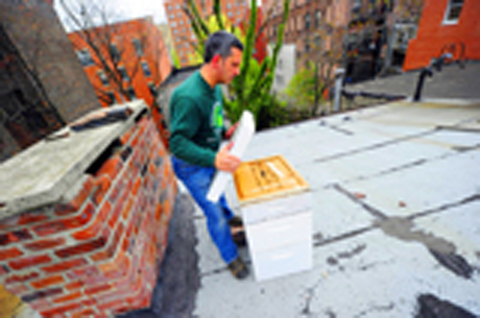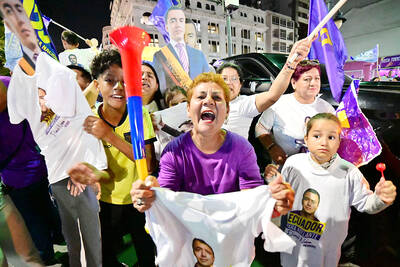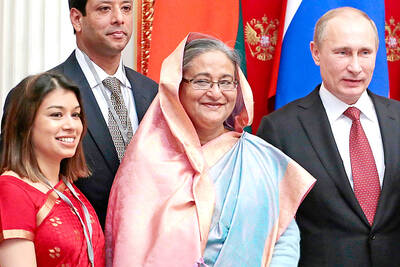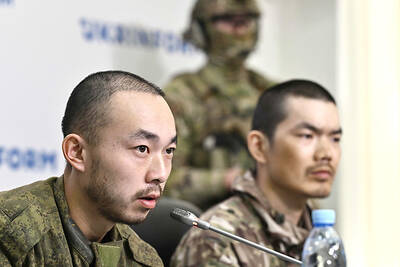Urban farming is a growth industry in New York city’s concrete jungle, and with little open land, agriculturalists and beekeepers have taken to the rooftops to pursue their passion.
Andrew Cote uses the emergency fire ladder to climb up to the roof of his East Village building, where he tends to 250 bee hives.
Cote, a professor of Japanese literature, doubles up as president of the New York City Beekeepers Association, and is happy that the city authorized beekeeping in the middle of last month after an 11-year ban.

PHOTO: AFP
“The city wants to plant 1 million trees, and the trees need to be pollinated,” Cote said.
The ban forced beekeepers into hiding, fearing a US$2,000 fine if caught. Now Cote believes the bees are vital to helping keep the city green.
“Our bees pollinate, and they clean the air. It is a way to connect with nature,” he said.
Bees also produce about 45kg of honey per hive per year, he said — honey that he sells at the city’s various farmer’s markets.
Cote said he has received several requests to install rooftop beehives, and the demand is such that yesterday he was scheduled to offer a course for aspiring apiculturalists.
On the other side of Manhattan, in the posh Upper East Side, Eli Zabar, owner of the upscale “Vinegar Factory” delicatessen, inspects the crops he is growing on the roof of the old factory bought in 1991.
“I began the green houses 15 years ago,” Zabar said. “I grow heirloom tomatoes, lots of different kinds of lettuce, herbs, basil, rosemary, thyme, raspberries, figs, beets. We use the heat of the bakeries and pastries, we recycle the heat. With the use of the heat we have eliminated our [carbon] footprint.”
“You harvest in the morning, you sell in the afternoon, you don’t refrigerate, it tastes better,” Zabar said. “We pick everything ripe and ready to eat. All our products here are organic.”
Depending on the time of day, Zabar says with a smile, “the green houses smell of bread, brownie or croissant.”
About half of the items Zabar sells in his deli comes from rooftop farms.
From Manhattan to Brooklyn, whether on rooftops, backyards or in any of the city’s 600 community gardens, urban farming is a growing phenomenon.
The movement is helped along by Mayor Michael Bloomberg, who seeks to turn the city into a sustainable development champion. Through “PlaNYC 2030,” a program he launched on Earth Day 2007, people who install “green roofs” can get a tax break.
At Randall’s Island, in New York’s East River, the city’s Parks and Recreation Department is currently testing 16 different types of vegetation that could be placed on the roofs of schools, hospitals or other public buildings.
“These are patches of succulent vegetation, like sedum, which protect the roofs, [and] isolate the buildings from the heat because the UV [ultra-violet] sun is not hitting,” senior project manager John Robilotti said.

Incumbent Ecuadoran President Daniel Noboa on Sunday claimed a runaway victory in the nation’s presidential election, after voters endorsed the young leader’s “iron fist” approach to rampant cartel violence. With more than 90 percent of the votes counted, the National Election Council said Noboa had an unassailable 12-point lead over his leftist rival Luisa Gonzalez. Official results showed Noboa with 56 percent of the vote, against Gonzalez’s 44 percent — a far bigger winning margin than expected after a virtual tie in the first round. Speaking to jubilant supporters in his hometown of Olon, the 37-year-old president claimed a “historic victory.” “A huge hug

Two Belgian teenagers on Tuesday were charged with wildlife piracy after they were found with thousands of ants packed in test tubes in what Kenyan authorities said was part of a trend in trafficking smaller and lesser-known species. Lornoy David and Seppe Lodewijckx, two 19-year-olds who were arrested on April 5 with 5,000 ants at a guest house, appeared distraught during their appearance before a magistrate in Nairobi and were comforted in the courtroom by relatives. They told the magistrate that they were collecting the ants for fun and did not know that it was illegal. In a separate criminal case, Kenyan Dennis

A judge in Bangladesh issued an arrest warrant for the British member of parliament and former British economic secretary to the treasury Tulip Siddiq, who is a niece of former Bangladeshi prime minister Sheikh Hasina, who was ousted in August last year in a mass uprising that ended her 15-year rule. The Bangladeshi Anti-Corruption Commission has been investigating allegations against Siddiq that she and her family members, including Hasina, illegally received land in a state-owned township project near Dhaka, the capital. Senior Special Judge of Dhaka Metropolitan Zakir Hossain passed the order on Sunday, after considering charges in three separate cases filed

APPORTIONING BLAME: The US president said that there were ‘millions of people dead because of three people’ — Vladimir Putin, Joe Biden and Volodymyr Zelenskiy US President Donald Trump on Monday resumed his attempts to blame Ukrainian President Volodymyr Zelenskiy for Russia’s invasion, falsely accusing him of responsibility for “millions” of deaths. Trump — who had a blazing public row in the Oval Office with Zelenskiy six weeks ago — said the Ukranian shared the blame with Russian President Vladimir Putin, who ordered the February 2022 invasion, and then-US president Joe Biden. Trump told reporters that there were “millions of people dead because of three people.” “Let’s say Putin No. 1, but let’s say Biden, who had no idea what the hell he was doing, No. 2, and